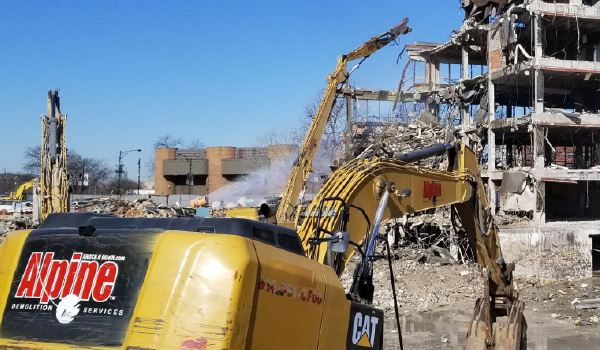The Ultimate Overview to Interior Demolition Techniques and Equipments
Within the world of indoor remodellings, the art of demolition is a pivotal stage that requires precision, ability, and the right set of tools. Whether you are a seasoned specialist or a DIY enthusiast, recognizing the details of interior demolition techniques can make all the difference in attaining an effective job end result.
Necessary Interior Demolition Devices
When undertaking indoor demolition projects, having the suitable tools is crucial for effectiveness and safety and security. Among the most vital devices for interior demolition is the demolition hammer. This durable device is designed to break through tough materials like concrete, drywall, and floor tile. Its effective hammering action can rapidly destroy wall surfaces, floorings, and various other frameworks. Additionally, a pry bar is indispensable for eliminating components, trim, and various other products. Its utilize permits the very easy extraction of nails and other fasteners without harming the surrounding surface areas - interior demolition.
Another necessary tool is a reciprocating saw, which is perfect for reducing through a selection of products such as plastic, steel, and timber. Its capacity to make precise cuts in limited areas makes it ideal for demolition work. In addition, an energy knife is necessary for reducing products like rug, vinyl flooring, and insulation. Its sharp blade makes certain clean and precise cuts, helping with the elimination of undesirable materials. Overall, having these important interior demolition tools will substantially boost the effectiveness and safety of any kind of demolition job.

Safety Preventative Measures Throughout Demolition

In addition, all employees involved in the demolition process should get sufficient training on the proper handling of devices and tools to minimize mishaps. By adhering to these safety and security precautions, indoor demolition jobs can be carried out efficiently while prioritizing the well-being of all individuals included.
Strategies for Eliminating Walls
Applying appropriate security preventative measures during interior demolition projects is vital for developing a secure workplace, and one key aspect of such projects involves understanding techniques for getting rid of walls. One frequently utilized technique is manual demolition, which requires making use of basic hand devices such as sledgehammers, crowbars, and energy knives to very carefully dismantle the wall item by piece. This strategy enables for greater control over the demolition process, especially in fragile locations where precision is essential.
For bigger, extra intricate walls, mechanical demolition may be required. This includes utilizing heavy sites equipment like bulldozers or excavators to tear down wall surfaces effectively. Nevertheless, it is crucial to guarantee that the architectural integrity of the structure is not endangered throughout mechanical demolition.
Another strategy for getting rid of wall surfaces is deconstruction, where the wall is dismantled in a method that maintains multiple-use materials. This sustainable strategy is environmentally friendly and can also assist minimize disposal expenses. Whichever technique is utilized, it is necessary to adhere to correct security procedures and consider the structural ramifications of wall removal to guarantee a successful indoor demolition task.
Removing Floor Covering Like a Pro
Successfully removing floor covering throughout interior demolition needs the correct devices and methods to guarantee a smooth and successful process. The initial step in getting rid of flooring is to clear the area of any furniture or barriers. Next, recognize the kind of floor covering to establish the ideal removal approach. For hardwood or laminate flooring, begin by getting rid of the walls and after that make use of a flooring scrape to raise and detach the slabs. Carpeting removal entails reducing the carpeting right into workable sections and rolling it up for disposal. For ceramic tile or plastic flooring, a chisel or flooring scrape can be used to tear up the sheets or tiles. It's vital to use safety equipment such as handwear covers, safety glasses, and a mask to avoid injuries and exposure to dust and debris. In addition, having a dumpster or assigned disposal area ready for the removed flooring materials is crucial for maintaining a clean workplace. By complying with these techniques and using the right tools, getting rid of floor covering like a pro can be achieved successfully and efficiently.
Correct Garbage Disposal Methods
After effectively getting rid of floor covering making use of the suitable tools and techniques, the following vital action in the interior demolition procedure is executing appropriate waste disposal methods. Proper waste disposal my review here is crucial for preserving a tidy and secure job environment throughout and after demolition.

Specialists need to stick to regional laws relating to garbage disposal to avoid fines and penalties. Using expert waste monitoring services can enhance the disposal process and make certain compliance with ecological standards. By applying correct waste disposal approaches, interior demolition projects can be finished successfully and sustainably.
Final Thought
In verdict, indoor demolition calls for using important tools and stringent safety precautions to ensure a effective and safe process. Techniques for eliminating wall surfaces and floor covering need to be done carefully and successfully to stay clear of any kind of damage or accidents. Correct garbage disposal techniques are also important to maintain a tidy and well organized workplace. By adhering to these guidelines, indoor demolition can be finished efficiently and with minimal threats.
One of the most vital tools for indoor demolition is the demolition hammer (interior demolition). On the whole, having these necessary interior demolition tools will substantially boost the effectiveness and safety of any kind of demolition task
Effectively eliminating floor covering during interior demolition needs the appropriate devices and strategies to guarantee click this a successful and smooth process.After efficiently removing flooring making use of the appropriate tools and strategies, the following critical step in the indoor demolition procedure is applying correct waste disposal techniques.In final thought, interior demolition requires the usage of vital tools and strict safety and security precautions to ensure a risk-free and effective process.